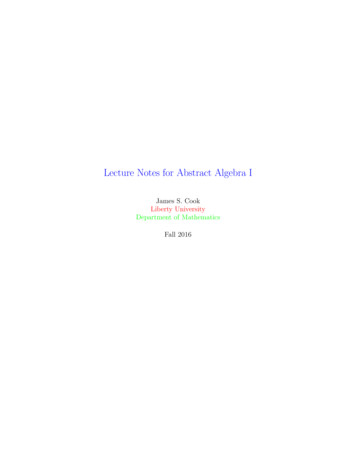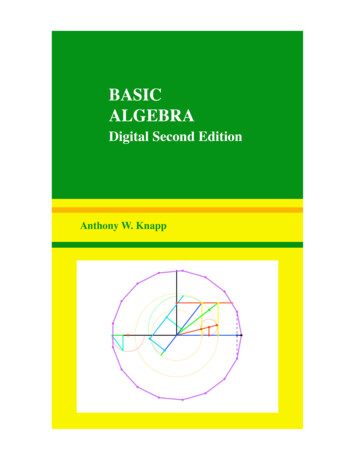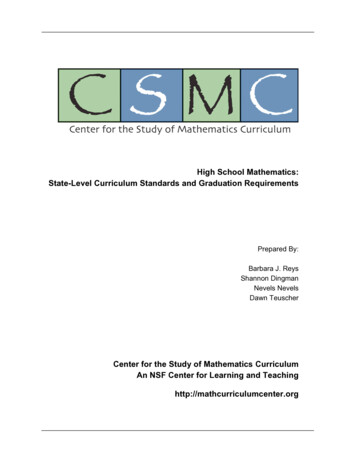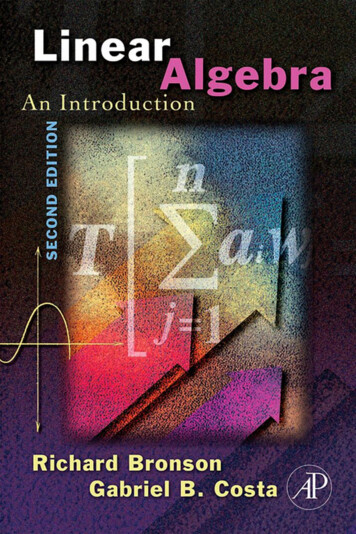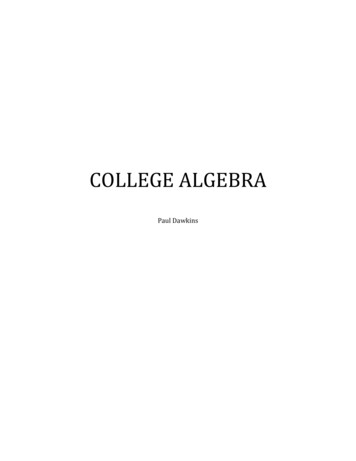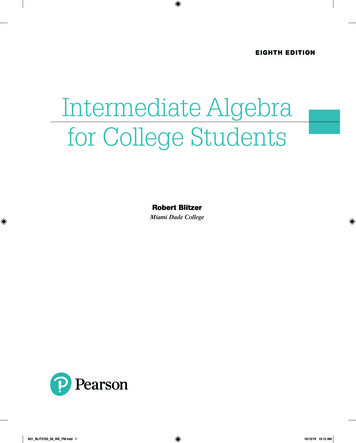
Transcription
Introduction to Modern AlgebraDavid JoyceClark UniversityVersion 1.2.7, 5 Dec 20171 Copyright(C) 2008,2017.1
iiI dedicate this book to my friend and colleague Arthur Chou. Arthur encouraged me to writethis book. I’m sorry that he did not live to see it finished.Arthur was born in 1954 in Taipei, Taiwan. He received his bachelors in mathematicsin 1976 from Tunghai University and his PhD from Stony Brook in 1982. After a year atthe Institute for Advanced Study at Princeton, he joined Clark University in 1983. He waspromoted to Associate Professor six years later and promoted to full professor in 2008, theyear he died. Besides mathematics, he had many other interests. Among other things, he wasthe general manager of the North America Elite Youth Orchestra which performed at Dallas,Beijing, and Taipei, and he was the deacon of the Chinese Gospel Church in Southborough,Massachusetts.
ContentsList of FiguresviList of Tablesviii1 Introduction1.1 Algebra . . . . . . . . . . . . . . . . . . . . . . . . . . . . . . . .1.2 Structures in Modern Algebra . . . . . . . . . . . . . . . . . . . .1.2.1 Operations on sets . . . . . . . . . . . . . . . . . . . . . .1.2.2 Fields . . . . . . . . . . . . . . . . . . . . . . . . . . . . .1.2.3 Rings . . . . . . . . . . . . . . . . . . . . . . . . . . . . .1.2.4 Groups . . . . . . . . . . . . . . . . . . . . . . . . . . . . .1.2.5 Other algebraic structures besides fields, rings, and groups1.3 Isomorphisms, homomorphisms, etc. . . . . . . . . . . . . . . . . .1.3.1 Isomorphisms . . . . . . . . . . . . . . . . . . . . . . . . .1.3.2 Homomorphisms . . . . . . . . . . . . . . . . . . . . . . .1.3.3 Monomorphisms and epimorphisms . . . . . . . . . . . . .1.3.4 Endomorphisms and automorphisms . . . . . . . . . . . .1.4 A little number theory . . . . . . . . . . . . . . . . . . . . . . . .1.4.1 Mathematical induction on the natural numbers N . . . .1.4.2 Divisibility . . . . . . . . . . . . . . . . . . . . . . . . . . .1.4.3 Prime numbers . . . . . . . . . . . . . . . . . . . . . . . .1.4.4 The Euclidean algorithm . . . . . . . . . . . . . . . . . . .1.5 The fundamental theorem of arithmetic . . . . . . . . . . . . . . .1.6 Polynomials. . . . . . . . . . . . . . . . . . . . . . . . . . . . . . .1.6.1 Division for polynomials . . . . . . . . . . . . . . . . . . .1.6.2 Roots of unity and cyclotomic polynomials . . . . . . . . .11224561011111213141515161719222526282 Fields2.1 Introduction to fields . . . . . . . . . . . . . . . . .2.1.1 Definition of fields . . . . . . . . . . . . . .2.1.2 Subtraction, division, multiples, and powers2.1.3 Properties that follow from the axioms . . .2.1.4 Subfields . . . . . . . . . . . . . . . . . . . .2.1.5 Fields of rational functions . . . . . . . . . .2.1.6 Vector spaces over arbitrary fields . . . . . .2.2 Cyclic rings and finite fields . . . . . . . . . . . . .313131323334353535iii.
ivCONTENTS2.32.42.52.2.1 The cyclic ring Zn . . . . . . . . . . . . . . . .2.2.2 The cyclic prime fields Zp . . . . . . . . . . . .2.2.3 Characteristics of fields, and prime fields . . . .Field Extensions, algebraic fields, the complex numbers2.3.1 Algebraic fields . . . . . . . . . . . . . . . . . .2.3.2 The field of complex numbers C . . . . . . . . .2.3.3 General quadratic extensions . . . . . . . . . . .Real numbers and ordered fields . . . . . . . . . . . . .2.4.1 Ordered fields . . . . . . . . . . . . . . . . . . .2.4.2 Archimedean orders . . . . . . . . . . . . . . . .2.4.3 Complete ordered fields . . . . . . . . . . . . . .Skew fields (division rings) and the quaternions . . . .2.5.1 Skew fields (division rings) . . . . . . . . . . . .2.5.2 The quaternions H . . . . . . . . . . . . . . . .3 Rings3.1 Introduction to rings . . . . . . . . . . . . . . . . . . . .3.1.1 Definition and properties of rings . . . . . . . . .3.1.2 Products of rings . . . . . . . . . . . . . . . . . .3.1.3 Integral domains . . . . . . . . . . . . . . . . . .3.1.4 The Gaussian integers, Z[i] . . . . . . . . . . . .3.1.5 Finite fields again . . . . . . . . . . . . . . . . . .3.2 Factoring Zn by the Chinese remainder theorem . . . . .3.2.1 The Chinese remainder theorem . . . . . . . . . .3.2.2 Brahmagupta’s solution . . . . . . . . . . . . . .3.2.3 Qin Jiushao’s solution . . . . . . . . . . . . . . .3.3 Boolean rings . . . . . . . . . . . . . . . . . . . . . . . .3.3.1 Introduction to Boolean rings . . . . . . . . . . .3.3.2 Factoring Boolean rings . . . . . . . . . . . . . .3.3.3 A partial order on a Boolean ring . . . . . . . . .3.4 The field of rational numbers, fields of fractions . . . . .3.5 Categories and the category of rings . . . . . . . . . . . .3.5.1 The formal definition of categories . . . . . . . . .3.5.2 The category R of rings . . . . . . . . . . . . . .3.5.3 Monomorphisms and epimorphisms in a category3.6 Kernels, ideals, and quotient rings . . . . . . . . . . . . .3.6.1 Kernels of ring homomorphisms . . . . . . . . . .3.6.2 Ideals of a ring . . . . . . . . . . . . . . . . . . .3.6.3 Quotient rings, R/I . . . . . . . . . . . . . . . . .3.6.4 Prime and maximal ideals . . . . . . . . . . . . .3.7 Krull’s theorem . . . . . . . . . . . . . . . . . . . . . . .3.8 UFDs, PIDs, and EDs . . . . . . . . . . . . . . . . . . .3.8.1 Divisibility in an integral domain . . . . . . . . .3.8.2 Unique factorization domains . . . . . . . . . . .3.8.3 Principal ideal domains . . . . . . . . . . . . . . .3.8.4 Euclidean domains . . . . . . . . . . . . . . . . 626364656667697071737474747678798080818284
CONTENTSv3.9Real and complex polynomial rings R[x] and C[x] . . . . . . . . . . . . . . .3.9.1 C[x] and the Fundamental Theorem of Algebra . . . . . . . . . . . .3.9.2 The polynomial ring R[x] . . . . . . . . . . . . . . . . . . . . . . . .3.10 Rational and integer polynomial rings . . . . . . . . . . . . . . . . . . . . . .3.10.1 Roots of polynomials . . . . . . . . . . . . . . . . . . . . . . . . . . .3.10.2 Gauss’s lemma and Eisenstein’s criterion . . . . . . . . . . . . . . . .3.10.3 Prime cyclotomic polynomials . . . . . . . . . . . . . . . . . . . . . .3.10.4 Polynomial rings with coefficients in a UFD, and polynomial rings inseveral variables. . . . . . . . . . . . . . . . . . . . . . . . . . . . . .3.11 Number fields and their rings of integers . . . . . . . . . . . . . . . . . . . .4 Groups4.1 Groups and subgroups . . . . . . . . . . . . . . . . . . . . . . . .4.1.1 Definition and basic properties of groups . . . . . . . . . .4.1.2 Subgroups . . . . . . . . . . . . . . . . . . . . . . . . . . .4.1.3 Cyclic groups and subgroups . . . . . . . . . . . . . . . . .4.1.4 Products of groups . . . . . . . . . . . . . . . . . . . . . .4.1.5 Cosets and Lagrange’s theorem . . . . . . . . . . . . . . .4.2 Symmetric Groups Sn . . . . . . . . . . . . . . . . . . . . . . . .4.2.1 Permutations and the symmetric group . . . . . . . . . . .4.2.2 Even and odd permutations . . . . . . . . . . . . . . . . .4.2.3 Alternating and dihedral groups . . . . . . . . . . . . . . .4.3 Cayley’s theorem and Cayley graphs . . . . . . . . . . . . . . . .4.3.1 Cayley’s theorem . . . . . . . . . . . . . . . . . . . . . . .4.3.2 Some small finite groups . . . . . . . . . . . . . . . . . . .4.4 The category of groups G . . . . . . . . . . . . . . . . . . . . . . .4.5 Conjugacy classes and quandles . . . . . . . . . . . . . . . . . . .4.5.1 Conjugacy classes . . . . . . . . . . . . . . . . . . . . . . .4.5.2 Quandles and the operation of conjugation . . . . . . . . .4.6 Kernels, normal subgroups, and quotient groups . . . . . . . . . .4.6.1 Kernels of group homomorphisms and normal subgroups .4.6.2 Quotient groups, and projections γ : G G/N . . . . . .4.6.3 Isomorphism theorems . . . . . . . . . . . . . . . . . . . .4.6.4 Internal direct products . . . . . . . . . . . . . . . . . . .4.7 Matrix rings and linear groups . . . . . . . . . . . . . . . . . . . .4.7.1 Linear transformations . . . . . . . . . . . . . . . . . . . .4.7.2 The general linear groups GLn (R) . . . . . . . . . . . . . .4.7.3 Other linear groups . . . . . . . . . . . . . . . . . . . . . .4.7.4 Projective space and the projective linear group P GLn (F )4.8 Structure of finite groups . . . . . . . . . . . . . . . . . . . . . . .4.8.1 Simple groups . . . . . . . . . . . . . . . . . . . . . . . . .4.8.2 The Jordan-Hölder theorem . . . . . . . . . . . . . . . . .4.9 Abelian groups . . . . . . . . . . . . . . . . . . . . . . . . . . . .4.9.1 The category A of Abelian groups . . . . . . . . . . . . . .4.9.2 Finite Abelian groups . . . . . . . . . . . . . . . . . . . . .87878990909295. 95. 37
viCONTENTSAppendicesA Background mathematicsA.1 Logic and proofs . . . . . . . . .A.2 Sets . . . . . . . . . . . . . . . .A.2.1 Basic set theory . . . . . .A.2.2 Functions and relations . .A.2.3 Equivalence relations . . .A.2.4 Axioms of set theory . . .A.3 Ordered structures . . . . . . . .A.3.1 Partial orders and posets.A.3.2 Lattices . . . . . . . . . .A.3.3 Boolean algebras. . . . . .A.4 Axiom of choice . . . . . . . . . .A.4.1 Zorn’s lemma . . . . . . .A.4.2 Well-ordering principle . 59161
List of Figures1.11.21.31.4Equilateral triangle with lines ofUnit circle S 1 . . . . . . . . . .Divisors of 432 . . . . . . . . .Divisibility up through 12 . . .symmetry. . . . . . . . . . . . . . . .2.1Cyclic rings Z6 , Z19 , Z . . . . . . . . . . . . . . . . . . . . . . . . . . . . . . . 373.13.23.33.4Lattice of Gaussian integers Z[i] . .Free Boolean ring on two elements .Lattice of Eisenstein integers . . . .Primitive 7th roots of unity . . . . bgroups of S3 . . . . . . . . . . . . . . . . . . . .Symmetries of a pentagon . . . . . . . . . . . . . .Symmetries of a cube and tetrahedron . . . . . . .Cayley graph for D5 . . . . . . . . . . . . . . . . .Cayley graph for A4 . . . . . . . . . . . . . . . . .Distributivity in a involutory quandle . . . . . . . .A conjugacy class in the quaternion group . . . . .The conjugacy class of transpositions in S4 . . . . .The Fano plane Z2 P 2 . . . . . . . . . . . . . . . . .The projective plane Z3 P 2 . . . . . . . . . . . . . .Cayley graph of the Frobenius group F21 C7 o C3Heptahedron on a torus . . . . . . . . . . . . . . .107108109111113118119120128129134135. 8. 10. 17. 17A.1 Lattice of the Powerset of 4 elements . . . . . . . . . . . . . . . . . . . . . . . 157vii
viiiLIST OF FIGURES
List of Tables1.1Composition table for six particular rational functions. . . . . . . . . . . . . .93.1Notations in Boolean algebras, set theory, and Boolean rings. . . . . . . . . . . 654.1List of small groups . . . . . . . . . . . . . . . . . . . . . . . . . . . . . . . . . 114A.1 Standard logical symbols . . . . . . . . . . . . . . . . . . . . . . . . . . . . . . 144ix
xLIST OF TABLES
Chapter 1Introduction1.1AlgebraThe word “algebra” means many things. The word dates back about 1200 years ago to partof the title of al-Khwārizmı̄’s book on the subject, but the subject itself goes back 4000 yearsago to ancient Babylonia and Egypt. It was about solving numerical problems that we wouldnow identify as linear and quadratic equations. Versions of the quadratic formula were usedto find solutions to those quadratic equations. Al-Khwārizmı̄ (ca. 780–ca. 850) codified thealgorithms (“algorithm” is a word derived from his name) for solving these equations. Hewrote all his equations out in words since symbolic algebra had yet to be invented.Other places in the world also had algebra and developed various aspects of it. The ancientChinese solved systems of simultaneous linear equations and later developed algorithms tofind roots of polynomials of high degree. Various aspects of number theory were studied inChina, in India, and by Greek mathematicians.Symbolic algebra was developed in the 1500s. Symbolic algebra has symbols for thearithmetic operations of addition, subtraction, multiplication, division, powers, and roots aswell as symbols for grouping expressions (such as parentheses), and most importantly, usedletters for variables.Once symbolic algebra was developed in the 1500s, mathematics flourished in the 1600s.Coordinates, analytic geometry, and calculus with derivatives, integrals, and series were developed in that century.Algebra became more general and more abstract in the 1800s as more algebraic structureswere invented. Hamilton (1805–1865) invented quaternions (see section 2.5.2) and Grassmann(1809–1977) developed exterior algebras in the 1840s, both of which led to vector spaces. (Seesection 2.1.6 for vector spaces.)Groups were developed over the 1800s, first as particular groups of substitutions or permutations, then in the 1850’s Cayley (1821–1895) gave the general definition for a group.(See chapter 2 for groups.)Several fields were studied in mathematics for some time including the field of real numbersthe field of rational number, and the field of complex numbers, but there was no generaldefinition for a field until the late 1800s. (See chapter 2 for fields.)Rings also were studied in the 1800s. Noether (1882–1935) gave general concept of commutative ring in 1921 which was later generalized to include noncommutative rings. (See1
2CHAPTER 1. INTRODUCTIONchapter 3 for rings.)We’ll introduce the concepts of field, ring, and group in the Introduction, then study eachin turn in the following chapters.1.2Structures in Modern AlgebraFields, rings, and groups. We’ll be looking at several kinds of algebraic structures thissemester, the three major kinds being fields in chapter 2, rings in chapter 3, and groups inchapter 4, but also minor variants of these structures.We’ll start by examining the definitions and looking at some examples. For the time being,we won’t prove anything; that will come in later chapters when we look at those structuresin depth.A note on notation. We’ll use the standard notation for various kinds of numbers. Theset of natural numbers, {0, 1, 2, . . .} is denoted N. The set of integers {. . . , 2, 1, 0, 1, 2, . . .}is denoted Z (for Zahlen, German for whole number). The set of rational numbers, that is,mwhere m is an integer and n is a nonzero integer, is denoted Q (fornumbers of the formn“quotient”). The set of all real numbers, including all positive numbers, all negative numbers,and 0, is denoted R. And the set of complex numbers, that is, numbers of the form x iywhere x and y are real numbers and i2 1, is denoted C.1.2.1Operations on setsFor background on sets, see the section A.2 in the appendix.We’re familiar with many operations on the real numbers R—addition, subtraction, multiplication, division, negation, reciprocation, powers, roots, etc.Addition, subtraction, and multiplication are examples of binary operations, that is,functions R R R which take two real numbers as their arguments and return anotherreal number. Division is almost a binary operation, but since division by 0 is not defined, it’sonly a partially defined binary operation. Most of our operations will be defined everywhere,but some, like divison, won’t be.Negation is a unary operation, that is, a function R R which takes one real numberas an argument and returns a real number. Reciprocation is a partial unary operation sincethe reciprocal of zero is not defined.The operations we’ll consider are all binary or unary. Ternary operations can certainlybe defined, but useful ternary operations are rare.Some of these operations satisfy familiar identities. For example, addition and multiplication are both commutative; they satisfy the identitiesx y y xandxy yx.A binary operation is said to be commutative when the order that the two arguments areapplied doesn’t matter, that is, interchanging them, or commuting one across the other,doesn’t change the result. Subtraction and division, however, are not commutative.
1.2. STRUCTURES IN MODERN ALGEBRA3Addition and multiplication are also associative binary operations(x y) z x (y z)and(xy)z x(yz).A binary operation is said to be associative when the parentheses can be associated witheither the first pair or the second pair when the operation is applied to three arguments andthe result is the same. Neither subtraction nor division are associative.Both addition and multiplication also have identity elements0 x x x 0and1x x x1.An identity element, also called a neutral element, for a binary operation is an element inthe set that doesn’t change the value of other elements when combined with them underthe operation. So, 0 is the identity element for addition, and 1 is the identity element formultiplication. Subtraction and division don’t have identity elements. (Well, they do on the1xright, since x 0 x and x, but not on the left, since usually 0 x 6 x and 6 x.)1xAlso, there are additive inverses and multiplicative inverses (for nonzero) elements. Thatis to say, given any x there is another element, namely x, such that x ( x) 0, and11given any nonzero x there is another element, namely such that x 1. Thus, a binaryxxoperation that has an identity element is said to have inverses if for each element there is aninverse element such that when combined by the operation they yield the identity elementfor the operation. Addition has inverses, and multiplication has inverses of nonzero elements.Finally, there is a particular relation between the operations of addition and multiplication, that of distributivity:x(y z) xy xzand(y z)x yx zx.Multiplication distributes over addition, that is, when multiplying a sum by x we can distribute the x over the terms of the sum.Exercise 1. On properties of operations.xyfor positive x and y a commutative operation?(a). Is the binary operation x y x yThat is, is it true that x y y x for all positive x and y? Is it associative? Explain youranswer.(b). Is it true that (w x) (y z) (w y) (x z) is an identity for real numbers?Can you say why or why not? (The word “identity” is used for an equation which holdswhenever both sides of the equation are defined and are equal.)(c). Although multiplication in R distributes over addition, addition doesn’t distributeover multiplication. Give an example where it doesn’t.Algebraic structures. We’ll define fields, rings, and groups as three kinds of algebraicstructures. An algebraic structure will have an underlying set, binary operations, unaryoperations, and constants, that have some of the properties mentioned above like commutativity, associativity, identity elements, inverse elements, and distributivity. Different kinds ofstructures will have different operations and properties.The algebraic structures are abstractions of familiar ones like those on the real numbersR, but for each kind of structure there will be more than one example, as we’ll see.
4CHAPTER 1. INTRODUCTION1.2.2FieldsInformally, a field is a set equipped with four operations—addition, subtraction, multiplication, and division that have the usual properties. (They don’t have to have the otheroperations that R has, like powers, roots, logs, and the myriad other functions like sin x.)Definition 1.1 (Field). A field is a set equipped with two binary operations, one calledaddition and the other called multiplication, denoted in the usual manner, which are bothcommutative and associative, both have identity elements (the additive identity denoted 0and the multiplicative identity denoted 1), addition has inverse elements (the inverse of x1denoted x), multiplication has inverses of nonzero elements (the inverse of x denoted orxx 1 ), multiplication distributes over addition, and 0 6 1.This definition will be spelled out in detail in chapter 2.Of course, one example of a field in the field of real numbers R. What are some others?Example 1.2 (The field of rational numbers, Q). Another example is the field of rationalnumbers. A rational number is the quotient of two integers a/b where the denominator is not0. The set of all rational numbers is denoted Q. We’re familiar with the fact that the sum,difference, product, and quotient (when the denominator is not zero) of rational numbers isanother rational number, so Q has all the operations it needs to be a field, and since it’s partof the field of the real numbers R, its operations have the the properties necessary to be afield. We say that Q is a subfield of R and that R is an extension of Q. But Q is not all ofR since there are irrational numbers like 2.Example 1.3 (The field of complex numbers, C). Yet another example is the field of complexnumbers C. A complex number is a number of the form a bi where a and b are real numbersand i2 1. The field of real numbers R is a subfield of C. We’ll review complex numbersbefore we use them. See Dave’s Short Course on Complex Numbers at http://www.clarku.edu/ djoyce/complexIn chapter 2, we’ll study fields in detail, and we’ll look at many other fields. Some willonly have a finite number of elements. (They won’t be subfields of Q.) Some will have Q asa subfield but be subfields themselves of R or C. Some will be even larger.Exercise 2. On fields. None of the following are fields. In each case, the operations of additionand multiplication are the usual ones.(a). The integers Z do not form a field. Why not?(b). The positive real numbers {x R x 0} do not form a field. Why not?(c). The set of real numbers between 10 and 10, that is,( 10, 10) {x R 10 x 10}is not a field. Why not?
1.2. STRUCTURES IN MODERN ALGEBRA1.2.35RingsRings will have the three operations of addition, subtraction, and multiplication, but don’tnecessarily have division. Most of our rings will have commutative multiplication, but somewon’t, so we won’t require that multiplication be commutative in our definition. All the ringswe’ll look at have a multiplicative identity, 1, so we’ll include that in the definition.Definition 1.4 (Ring). A ring is a set equipped with two binary operations, one calledaddition and the other called multiplication, denoted in the usual manner, which are bothassociative, addition is commutative, both have identity elements (the additive identity denoted 0 and the multiplicative identity denoted 1), addition has inverse elements (the inverseof x denoted x), and multiplication distributes over addition. If multiplication is also commutative, then the ring is called a commutative ring.Of course, all fields are automatically rings, in fact commutative rings, but what are someother rings?Example 1.5 (The ring of integers, Z). The ring of integers Z includes all integers (wholenumbers)—positive, negative, or 0. Addition, subtraction, and multiplication satisfy therequirements for a ring, indeed, a commutative ring. But there are no multiplicative inversesfor any elements except 1 and 1. For instance, 1/2 is not an integer. We’ll find that althoughthe ring of integers looks like it has less structure than a field, this very lack of structure allowsus to discover more about integers. We’ll be able to talk about prime numbers, for example.Example 1.6 (Polynomial rings). A whole family of examples are the rings of polynomials.Let R be any commutative ring (perhaps a field), and let R[x] include all polynomials withcoefficients in R. We know how to add, subtract, and multiply polynomials, and theseoperations have the properties required to make R[x] a commutative ring. We have, forinstance, the ring of polynomials with real coefficients R[x], the ring with integral coefficientsZ[x], etc.Example 1.7 (Matrix rings). How about an example ring that’s not commutative? The ringof n n matrices with entries in a commutative ring R gives such an example, this ring beingdenoted Mn (R). This ring, Mn (R), won’t be commutative when n 2. An example of amatrix ring is the ring of 2 2 matrices with real entries, M2 (R). Addition and subtractionare computed coordinatewise.The additive identity, 0, of this matrix ring is the matrix with 0 0all 0 entries, 0 . Matrix multiplication is not coordinatewise, but it is associative,0 0and multiplication does distribute over addition. The multiplicative identity for this matrixring is what’s usually calledthe identity matrix, denoted I. It has 1’s down the main diagonal1 0and 0’s elsewhere, 1 .0 1Sylvester (1814–1897), in 1850, called rectangular arrangements of numbers matrices, andCayley wrote much about them in his papers of 1855–1858.Example 1.8 (Integers modulo n). An important family of rings is the ring of integersmodulo n. We’ll study this in more detail later in section 2.2, but here’s an incompleteoverview. Fix a positive integer n. Think of two integers a and b as being the same modulon if n divides b a. In that case, we’ll say that a and b are congruent modulo n, and we’ll
6CHAPTER 1. INTRODUCTIONuse the notation Gauss (1777–1855) developed, a b (mod n), to denote that congruence.Congruence is commonly used in the study of number theory. This meaning of the Latinword “modulo” was introduced into mathematics by Gauss in 1801.Note that there are only n distinct integers modulo n, namely 0 through n 1, since thoseare the only remainders you can get when you divide an integer by n. These remaindersare also called “residues”. We can represent integers modulo n by these remainders from 0through n 1. Thus, we’ll say, for instance, that 5 plus 3 equals 1 modulo 7, by which wemean 5 3 1 (mod 7). Thus, we can turn congruence modulo n, which is an equivalencerelation on Z into equality on an n-element set. That n-element set is denoted Z/nZ, readZ modulo nZ, or more simply as Zn , read Z mod n. So, we can take the elements of Zn tobe the integers from 0 through n 1, where we understand that addition, subtraction, andmultiplication are done modulo n. And it turns out that this is a ring, as we’ll see when westudy Zn in detail.Incidentally, when n is a prime number p, then Zp is not just a ring, but a field, as willbe discussed in section 2.2.Exercise 3. On rings. None of the following are rings. In each case, the operations of additionand multiplication are the usual ones.(a). The set of nonzero integers, {x Z x 6 0} is not a ring. Why not?(b). The set of even integers {2x x Z} is not a ring. Why not?(c). The set of odd degree polynomials with real coefficients{f (x) R[x] the degree of f (x) is odd}is not a ring. Why not? (How about the set of even degree polynomials?)Exercise 4. On noncommutative rings. Are the following rings? (The operations are theusual matrix operations.) Explain in a sentence or two, but a proof is not necessary.(a). The set of all matrices with real coefficients (all sizes).(b). The set of all 2 2 matrices with real entries of the form a b.0 d(c). The set of all 2 2 matrices with real entries of the form a b. b aIn chapter 3 we’ll analyze rings in more detail.1.2.4GroupsUnlike fields and rings which have two primary binary operations, groups only have onebinary operation.Definition 1.9 (Group). A group is a set equipped with a binary operation that is associative, has an identity element, and has inverse elements. If, furthermore, multiplication is
1.2. STRUCTURES IN MODERN ALGEBRA7commutative, then the group is called a commutative group or an Abelian group. Abeliangroups can be denoted either additively or multiplicatively, but nonabelian groups are usually denoted multiplicatively. We’ll use the term order of the group to indicate how manyelements a group G has and denote this order by G .Example 1.10 (The underlying additive group of a ring). Of course, if you have a fieldor ring, and just consider addition (and forget about multiplication) you’ve got an Abeliangroup. Sometimes this is called the underlying additive group of the field or ring. We’ll usethe same notation for the underlying additive group as we do for the ring. Thus, Z couldmean either the ring of integers or the Abelian group of integers under addition, dependingon the context.Example 1.11 (Finite cyclic groups). The underlying group of the ring Zn is called a cyclicgroup. It’s e
He received his bachelors in mathematics in 1976 from Tunghai University and his PhD from Stony Brook in 1982. After a year at the Institute for Advanced Study at Princeton, he joined Clark University in 1983. He was promoted to Associate Professor si





